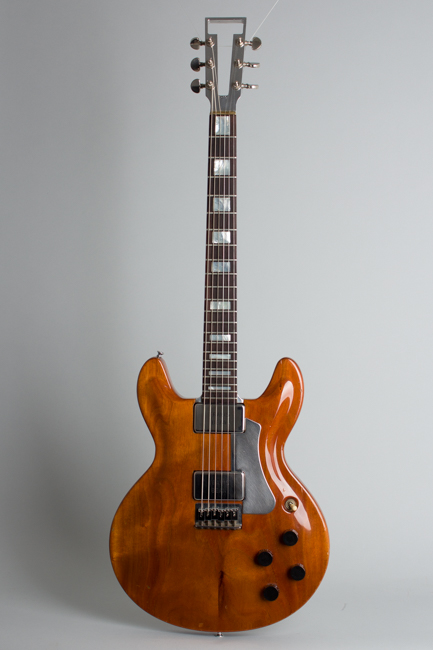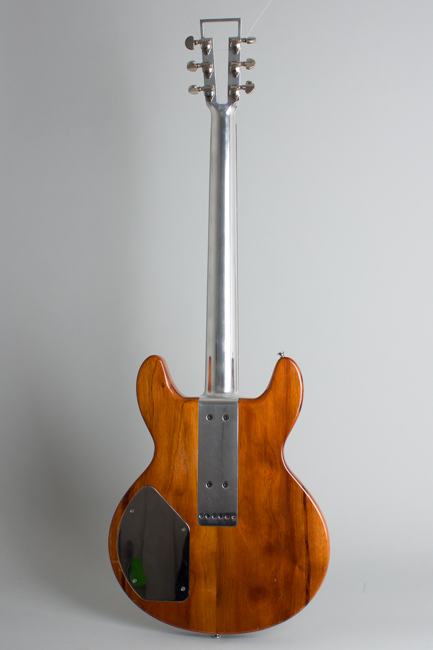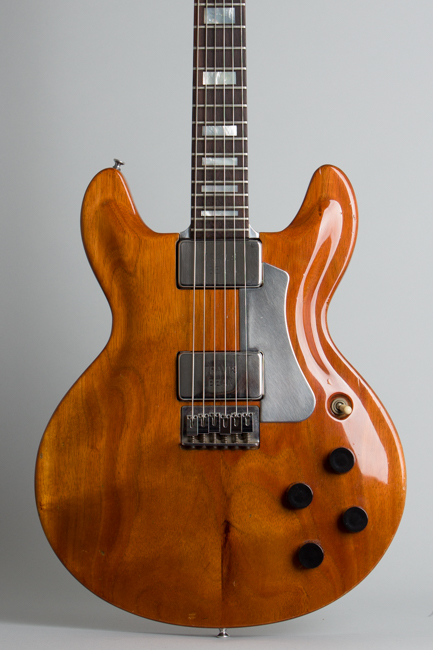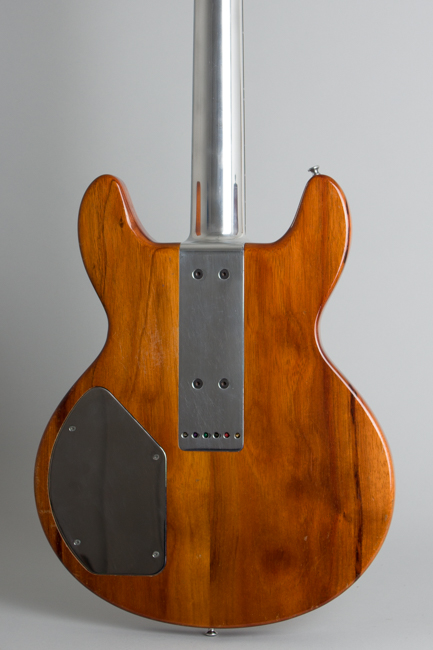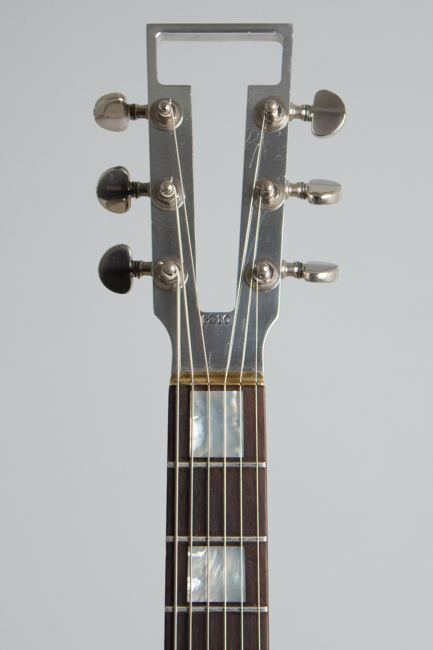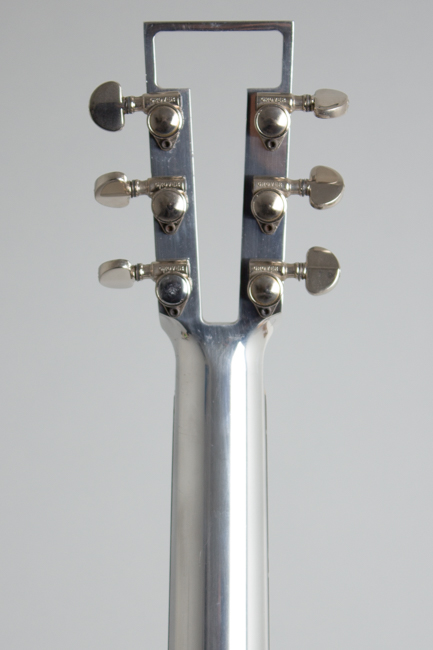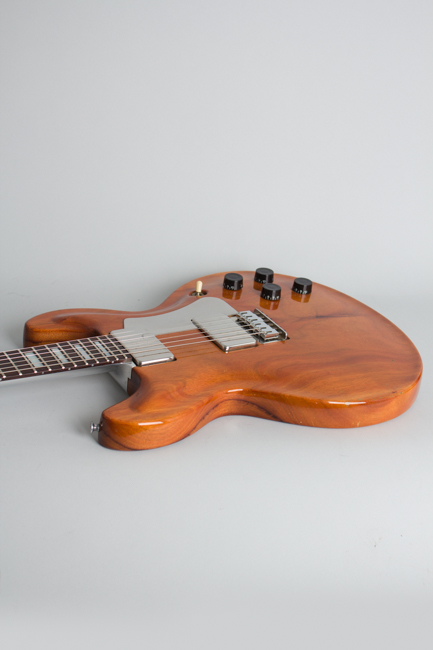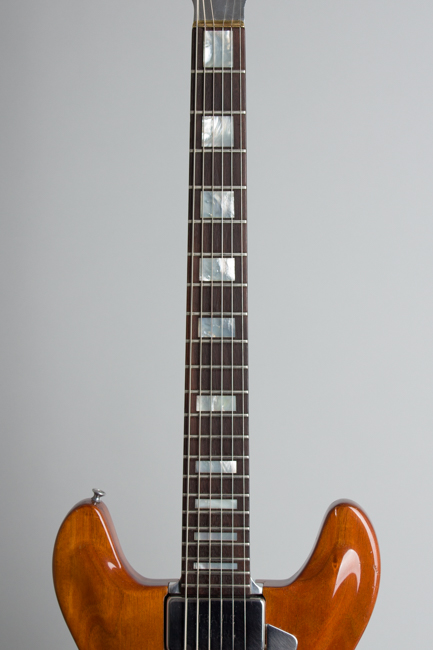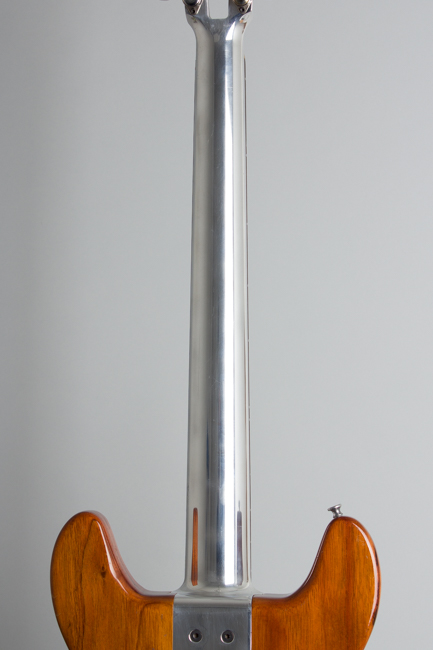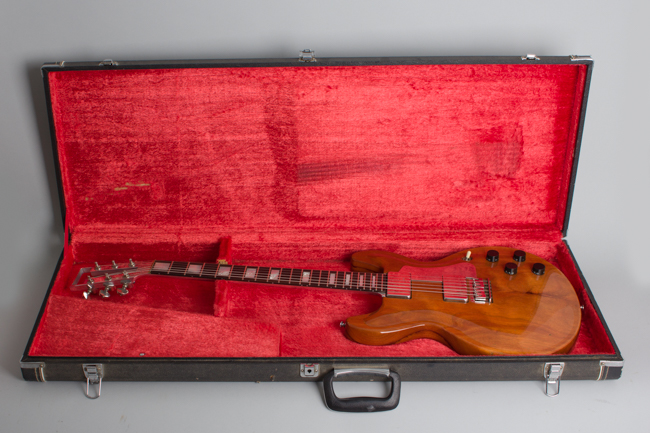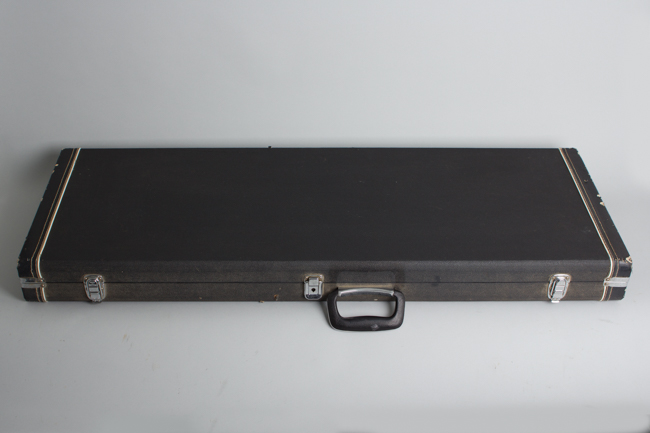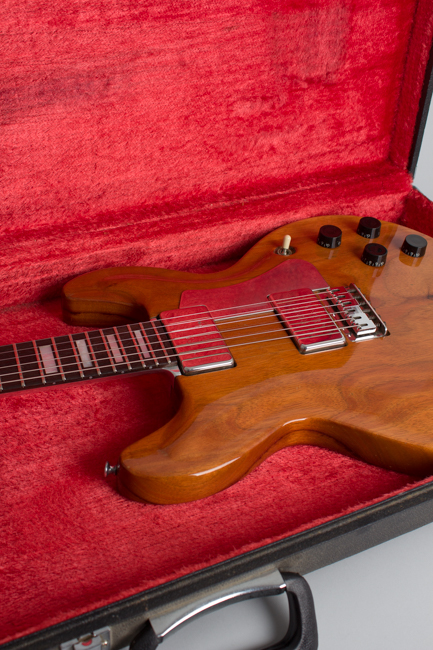Travis Bean TB-1000A Solid Body Electric Guitar (1977)
This item has been sold.
Item # 10552
Prices subject to change without notice.
Travis Bean TB-1000A Model Solid Body Electric Guitar (1977), made in Sun Valley, CA, natural lacquer finish, aluminum neck and centerpiece, koa wood body, rosewood fingetboard, black tolex hard shell case.
This striking 1970's classic is a Travis Bean TB1000A "Artist", the high-end model in the company's innovative but short-lived guitar line. It mates their patented raison d'etre aluminum neck/centerpiece with a carved solid Hawaiian koa wood body and pearl block inlaid ebony fingerboard. The company also offered the "Standard" TB1000S Bean model, similar in design but less deluxe, the budget TB-500 and the very eccentrically shaped "Wedge" models. Of all of these the TB-1000A is considered the "classic" Bean, the most widely recognized and fondly remembered signature model of the bunch.
Former motocross racer and lifelong tinkerer Clifford Travis Bean had two partners initially; guitar tech Marc McElwee and Gary Kramer, who would split off to found his own (for a time) hugely successful guitar operation. The ads claimed their aluminum-necked designs were "the first new development in the electric guitar since the 1930s" although whether they were considering the early cast aluminum Rickenbacker steels is not addressed! The catalog continued "The...lightweight neck and receiver system forms a rigid link between the tuning machines and the bridge. When the strings are attached, a complete vibration connection is achieved. It is this patented chassis that makes the Travis Bean guitar what it is: an instrument that has become the most dramatic breakthrough in electric guitar technology in 50 years."
Bean's patented concept was a through-neck/central body core milled from T6061 aircraft aluminum, extending from headstock to the through-the-body strung six-saddle bridge. Narrow chambers running its length improved resonance and reduced weight, if only slightly. This metal centerpiece is mounted into a lovely grained Hawaiian koa wood body finished in natural lacquer. The Standard, Artist, and Wedge models mounted the company's own Alnico magnet humbucking pickups with "Travis Bean" engraved on their covers - the only branding on the instrument besides the subtle "T" cut out of the headstock! These in-house pickups offer exceptional power and clarity and have a stellar reputation on their own; they were never used on any other instruments.
This Artist, carries serial number #1210 stamped into the headstock which would suggest manufacture in 1977, or 1978 at the latest. The electronics rig uses a matched set of pots with a visible date from the 39th week of 1976. This model retailed originally for $1,395, making it one of the most expensive solidbody guitars on the market at the time. While not a huge retail success they were featured by some major artists. At various times Keith Richards, Ron Wood, and Bill Wyman all played them with the Rolling Stones in the mid '70s, Wyman even having custom short-scale basses made for him. Jerry Garcia played both a TB 1000 and a TB 500 for a time, models which many deadheads still revere to this day. The guitars garnered a reputation for very high quality, but many players at the time felt the bare aluminum neck had a cold and clinical feel.
More recently, Travis Beans have been gainfully employed by a number of noise-rock players along with many denizens of myriad heavy sub-genres like doom and stoner metal. The Bean sound is powerful and articulate at lover volumes, but winds up magnificently to a shuddering crunch when pushed in these heavy contexts. Travis Bean knew he had something great in the mid-1970s; while his vision did not lead to major commercial success at the time he would no doubt be well satisfied by the lasting appeal to players and highly collectible status his creations have earned 45+ years on.
Overall length is 39 1/2 in. (100.3 cm.), 14 1/8 in. (35.9 cm.) wide at lower bout, and 1 3/8 in. (3.5 cm.) in depth, measured at side of rim. Scale length is 24 1/2 in. (622 mm.). Width of nut is 1 11/16 in. (43 mm.).
This guitar remains nicely original, showing some play wear but no abuse or alterations. The lacquer body finish has some general dings, dents and pick marks but no large areas of wear through to the wood. The back has some deeper belt buckle wear into but not through the finish, with scuffing to that part of the aluminum center, which for the most part is still quite shiny. The rear cap on the high E Rotomatic tuner appears to have been replaced and has some marks and scuffing on the back, likely related to being hammered back in place.
The rest of the metal surfaces show some fairly light wear, most notably scuffing to the pickguard. The back of the neck is very clean with no notable dings or dents into the metal. The original fairly large frets have been crowned down a bit but still have plenty of meat on them. The fingerboard shows hardly any wear.
This metal-neck marvel plays excellent and sounds fantastic. While it has been played in somewhat the gleaming aluminum neck still looks almost new and feels timelessly modern. The guitar is housed in a period (probably Japanese-made) hard case that fits well but is lighter grade than most US cases of the era. It does make the guitar a bit lighter to carry around! Overall Excellent - Condition.
This striking 1970's classic is a Travis Bean TB1000A "Artist", the high-end model in the company's innovative but short-lived guitar line. It mates their patented raison d'etre aluminum neck/centerpiece with a carved solid Hawaiian koa wood body and pearl block inlaid ebony fingerboard. The company also offered the "Standard" TB1000S Bean model, similar in design but less deluxe, the budget TB-500 and the very eccentrically shaped "Wedge" models. Of all of these the TB-1000A is considered the "classic" Bean, the most widely recognized and fondly remembered signature model of the bunch.
Former motocross racer and lifelong tinkerer Clifford Travis Bean had two partners initially; guitar tech Marc McElwee and Gary Kramer, who would split off to found his own (for a time) hugely successful guitar operation. The ads claimed their aluminum-necked designs were "the first new development in the electric guitar since the 1930s" although whether they were considering the early cast aluminum Rickenbacker steels is not addressed! The catalog continued "The...lightweight neck and receiver system forms a rigid link between the tuning machines and the bridge. When the strings are attached, a complete vibration connection is achieved. It is this patented chassis that makes the Travis Bean guitar what it is: an instrument that has become the most dramatic breakthrough in electric guitar technology in 50 years."
Bean's patented concept was a through-neck/central body core milled from T6061 aircraft aluminum, extending from headstock to the through-the-body strung six-saddle bridge. Narrow chambers running its length improved resonance and reduced weight, if only slightly. This metal centerpiece is mounted into a lovely grained Hawaiian koa wood body finished in natural lacquer. The Standard, Artist, and Wedge models mounted the company's own Alnico magnet humbucking pickups with "Travis Bean" engraved on their covers - the only branding on the instrument besides the subtle "T" cut out of the headstock! These in-house pickups offer exceptional power and clarity and have a stellar reputation on their own; they were never used on any other instruments.
This Artist, carries serial number #1210 stamped into the headstock which would suggest manufacture in 1977, or 1978 at the latest. The electronics rig uses a matched set of pots with a visible date from the 39th week of 1976. This model retailed originally for $1,395, making it one of the most expensive solidbody guitars on the market at the time. While not a huge retail success they were featured by some major artists. At various times Keith Richards, Ron Wood, and Bill Wyman all played them with the Rolling Stones in the mid '70s, Wyman even having custom short-scale basses made for him. Jerry Garcia played both a TB 1000 and a TB 500 for a time, models which many deadheads still revere to this day. The guitars garnered a reputation for very high quality, but many players at the time felt the bare aluminum neck had a cold and clinical feel.
More recently, Travis Beans have been gainfully employed by a number of noise-rock players along with many denizens of myriad heavy sub-genres like doom and stoner metal. The Bean sound is powerful and articulate at lover volumes, but winds up magnificently to a shuddering crunch when pushed in these heavy contexts. Travis Bean knew he had something great in the mid-1970s; while his vision did not lead to major commercial success at the time he would no doubt be well satisfied by the lasting appeal to players and highly collectible status his creations have earned 45+ years on.
Overall length is 39 1/2 in. (100.3 cm.), 14 1/8 in. (35.9 cm.) wide at lower bout, and 1 3/8 in. (3.5 cm.) in depth, measured at side of rim. Scale length is 24 1/2 in. (622 mm.). Width of nut is 1 11/16 in. (43 mm.).
This guitar remains nicely original, showing some play wear but no abuse or alterations. The lacquer body finish has some general dings, dents and pick marks but no large areas of wear through to the wood. The back has some deeper belt buckle wear into but not through the finish, with scuffing to that part of the aluminum center, which for the most part is still quite shiny. The rear cap on the high E Rotomatic tuner appears to have been replaced and has some marks and scuffing on the back, likely related to being hammered back in place.
The rest of the metal surfaces show some fairly light wear, most notably scuffing to the pickguard. The back of the neck is very clean with no notable dings or dents into the metal. The original fairly large frets have been crowned down a bit but still have plenty of meat on them. The fingerboard shows hardly any wear.
This metal-neck marvel plays excellent and sounds fantastic. While it has been played in somewhat the gleaming aluminum neck still looks almost new and feels timelessly modern. The guitar is housed in a period (probably Japanese-made) hard case that fits well but is lighter grade than most US cases of the era. It does make the guitar a bit lighter to carry around! Overall Excellent - Condition.
